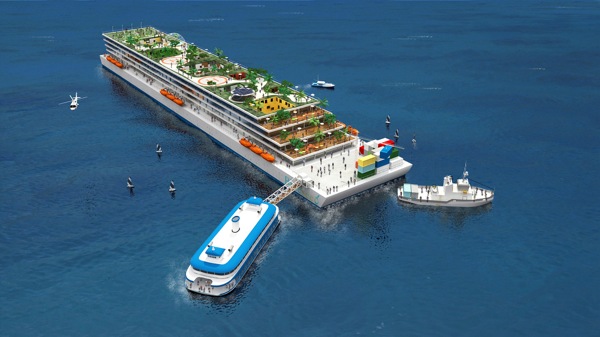Note: Hawaii’s startup community has been discussing incubators and accelerators for quite a while, and there’s been a lot of recent traction towards having a few of these entities actually launch. In the dozens of conversations I’ve had related to accelerators, however, a lot of challenges remain, particularly around structure, programming, and execution. To share my thoughts, I wrote this post, which originally appeared on Aloha Startups.
Content Makes an Accelerator Successful, Not Just Space and Money
Seems like every other person I talk with has a plan for a local incubator or accelerator aimed at helping Hawaii’s startups. There’s accelerator talk on almost every island, there’s interest in a social-impact incubator, there’s an idea for a live/work incubator, and there’s a chat about Hawaii’s first accelerator at this week’s Wetware Wednesday. Even the state government is getting into it—in a good way, for once—with the passage (yay!) of HB2319mandating a “Venture Accelerator Program,” and establishing $2M in venture accelerator funding. (It’s currently awaiting the governor’s signature.)

While it’s awesome that so much effort is being put into helping our startups grow and flourish, it starts to make you wonder how many such programs can Hawaii support? Are there enough startups to go around? Do we have the expertise locally to run it? Will we need to bring in a portion of the entrepreneurs from the mainland (which is a great idea, IMHO)? And how does this exacerbate (or help?) the “lack of talent” that so many local companies lament?
Accelerate vs. Incubate
In many of the conversations I’ve had, there still needs to be a clearer understanding of the difference between an accelerator and an incubator. The terms are frequently used interchangeably, but are far from the same thing, so let’s get this straight (for the most part…):
- An incubator helps to incubate ideas into startups, sometimes with money in return for significant equity (~20%, maybe more), and usually with workspace, connections with potential partners and co-founders, education, networking opportunities, advisers, and professional and other support. The term of incubation can last several months to several years. Incubators tend to be localized and supported by governments and/or universities, but not always (Y Combinator is trying out a new program that let’s teams apply without ideas).
- An accelerator takes very early-stage startups (i.e. have a product, a plan and a team) and helps to accelerate their transition into a viable business, almost always with investment (<10% equity plus access to more investors), high-potential connections and networks, professional support, workspace, and valuable mentoring, guidance, and education. Accelerated companies are usually expected to “graduate” within a few months to a year. Y Combinator, 500 Startups, and TechStars are a few the more well-known tech accelerators.
While even the entities themselves frequently use the terms interchangeably, Inc. magazine has a good article on the differences, Brad Feld had this to say (YouTube, starting at 0:45), as does Pittsburgh Ventures (disclosure: I grew up near Pittsburgh and put a premium on any website whose favicon is a Steelers logo) and many others.
Beyond the terminology and scope, they both have one similarity: it’s not just a space to work and investment, it’s a complete program.
It Takes More than Cash and a Desk
The key components, regardless of what it’s called, are the formalized and structuredopportunities for networking, guidance, education, and mentoring during the program. Workspace is great, but it’s no different than working at a Starbucks if it doesn’t come with access to experts, entrepreneurs with experience (in both success and failure), back office support, sources of funding, partnership potentials, and just straight advice.

You see, the whole purpose of creating a “space” for startups is to foster relationships that benefit the startup. Without providing connections, expertise, experience and networks that the entrepreneurs can’t get at a coffee shop, it’s really nothing more than a shared workspace. And, without creating some sort of application process to accept only those who are serious and capable, it’s not an accelerator or incubator, it’s a co-working space.
Don’t get me wrong, co-working spaces are fantastic. They fill a valuable niche and give entrepreneurs, remote workers, and others a nice, professional space to get some work done. There’s also opportunity to make great connections and learn something, but it’s usually by chance, not by design, and definitely not required.
Done Right, Accelerators Enhance a Team’s Skills
Look at what Y Combinator offers to their companies, and drill down to their list of speakers: it has names like Marc Andreessen, Marc Benioff, Jack Dorsey, Shawn Fanning, Reid Hoffman, Guy Kawasaki, Stephen Levy, Mark Pincus, Jeremy Stoppelman, Stephen Wolfram, and, well, you get the idea.
Sure, most of those tech “celebrities” live or work within a few miles of Silicon Valley’s accelerators, but it creates a challenge for Hawaii accelerators to develop the right programs featuring the right people. Should they use all local expertise, or bring it in from the mainland? Should they focus on tech, or areas where Hawaii already has vast talent? What should the startups expect of their mentors and of the curriculum? Should they expect to meet with Instagram and Zynga founders, or local execs from Hawaiian Airlines and non-tech successes like Sig Zane?
How are others doing it?
AlphaLabs, for example, provides weekly educational sessions with access to and advice from late-stage startup entrepreneurs, high-level execs from companies such as Microsoft, professors and researchers from local universities, and, of course, venture capitalists. They also provide attention and hands-on support from the AlphaLab team, staff, mentors and advisers, and the local business community.
Momentum Michigan provides a 12-week bootcamp program filled with events and networking opportunities.
TechStars goes further by providing more tangible support, like $5,000 in communications consulting, $10,000 in Paypal processing fees, $25,000 in AWS hosting services, and more. (Very similar to Startup America’s perks…)
500 Startups provides resident mentors and designers who “live and breathe with startups at the accelerator. They give talks, hold office hours, design reviews, hack on product, and provide ongoing support and guidance.”
Yetizen, a creative accelerator focused solely on gaming startups, focuses on four pillars of their approach: Education, Partnerships, Investors, and M&A (exit strategies).  They also offer a deep bench of hands-on expertise, with mentors from Disney, Sony, Google, Visa, and more.
To Improve Success Rates, They Don’t Accept Just Anyone
Most of the top accelerators also have rigorous application processes. TechStars claims “selection rates lower than the Ivy League,” has 25 deep questions on their application page, and requires videos and details of the company’s monetization plans.
Y Combinator asks thought-provoking questions that quickly weed out those who have a half-baked idea, haven’t done the research on their viability, or just plain don’t have the skills:
- Please tell us about the time you most successfully hacked some (non-computer) system to your advantage.Â
- What do you understand about your business that other companies in it just don’t get?
- How do or will you make money? How much could you make? (We realize you can’t know precisely, but give your best estimate.)
- How will you get users? If your idea is the type that faces a chicken-and-egg problem in the sense that it won’t be attractive to users till it has a lot of users (e.g. a marketplace, a dating site, an ad network), how will you overcome that?Â
It’s also apparent that, to be even considered for a program, you need more than just a great idea. You need the skills, you need to have thought it through, and you need to have created some sort of plan. (It’s funny to hear early entrepreneurs as they bash advice to think about their go-to-market strategy or to create rough revenue projections. Sure, everyone knows that they are just guesses, but you need to have an informed guess to be taken seriously.)
A comprehensive application and vetting process is a lot of work for both the startup and the accelerator, but it creates a high bar that helps to improve the long-term success rate of graduates. It also increases the learning by osmosis. If you’re a stellar team with a real shot at success, do you want to work alongside a lackluster team with a half-baked idea and wavering commitment? No, you don’t.
Garbage in, garbage out, right?
What Should Graduates Expect?
For most tech incubators and accelerators, the “graduation day” is a demo day, complete with press coverage, top-tier judges or feedback, and access to additional funding. That last bit is key, especially in tech.
TechStar grads average over $1M in outside venture capital raised after leaving their program (totaling $155M to date). BoomStartup, in Utah, holds an “Investor Day” with private investors, angel groups, venture capitalists, banks and other members of the ecosystem. Y Combinator’s latest batch of grads all received an additional $150k from prominent angel investors. Launchpad LA, in Los Angeles, has had 33 graduates, of which 27 raised more than $100M, combined, mostly based on connections made by their participation in Launchpad.
While the experience of the program should stand on it’s own, should success also be measured by a grad’s ability to secure additional funding? In the tech world, that’s almost always the case. But, in Hawaii, there’s a clear lack of investors and investment. So should Hawaii’s accelerators focus on different types of companies and expect different outcomes?
It sounds quaint these days, but what about incubating a non-tech company whose goal is a great product that drives profit, not VC investment? Would that take considerably more resources from the accelerator? Is tech the only sector sexy enough to get interest?
An Exciting Time for Hawaii’s Startups
It’s an exciting time to be a startup entrepreneur in Hawaii. From Wetware Wednesdays to Startup Hawaii, and Startup Weekend to accelerators and incubators, the opportunities for local startups to connect, grow, and succeed are becoming bigger and brighter. We’re seeing more and more startups grow beyond the idea stage, more entrepreneurs getting the connections and experience that they need, and more reason for talent to stay in Hawaii and help grow the startup ecosystem.
Regardless of how these first incubators and accelerators perform or how long they last, it’s all pushing us in the right direction. Being a startup entrepreneur is a gamble, and most fail. But, that failure is a learning experience.
For incubators and accelerators, it’s the same. There might be a few that win and a few that fade away, but it’s critical for Hawaii that they continue to try.
What do you think? There are a lot of unanswered questions in this post, so add your thoughts to the comments below…
And, if you’ve read this far you’re obviously interested, so attend Wetware Wednesday on May 23 to share your thoughts with the community.
Aloha!











